Eight Days, Assassination Attempts against King Jeongjo
Eight Days, Assassination Attempts against King Jeongjo (Korean: 정조암살미스터리 8일) is a South Korean television miniseries starring Kim Sang-joong, Park Jung-chul, Jung Ae-ri, Lee Seon-ho, and Hee Won. The series ran for 10 episodes, and was aired by CGV from November 17, 2007 to December 16, 2007. This show is placed in the context of the eight days procession organized in 1795 by King Jeongjo of Joseon to visit the tomb of his father at Hwaseong Fortress. This historic event was a huge one, involving 5,661 people and 1,417 horses.[1]
| Eight Days, Assassination Attempts against King Jeongjo | |
|---|---|
_poster.jpg) | |
| Also known as | Eight Days Mystery of Jeongjo Assassination |
| Genre | Period drama Drama |
| Based on | Journey by Oh Se-yeong |
| Written by | Kim Won-seok |
| Directed by | Park Jong-won |
| Starring | Kim Sang-joong Park Jung-chul Jung Ae-ri Lee Seon-ho Hee Won |
| Country of origin | South Korea |
| Original language(s) | Korean |
| No. of episodes | 10 |
| Production | |
| Executive producer(s) | Han Chang-hoon |
| Producer(s) | Go Jang-won Kim Do-yeon Ahn Sang-hwi Lee Joo-hyung |
| Running time | Saturdays and Sundays at 23:00 (KST) |
| Release | |
| Original network | CGV |
| Original release | November 17 – December 16, 2007 |
| External links | |
| Website | |
| Korean name | |
| Hangul | |
|---|---|
| Revised Romanization | Jeongjo Amsal Miseuteori Pal il |
| McCune–Reischauer | Chŏngjo Amsal Misŭtŏri P'al il |
Synopsis
The screenplay is based on the novel Journey[2] (Korean: 원행; RR: wonhaeng; lit. "a round trip") written in 2006 by Oh Se-yeong. The background of the action is the 1795 procession organized by King Jeongjo of Joseon for the 60th birthday of his mother, Lady Hyegyeong, that also commemorated the 60th birthday of his deceased father, the Crown Prince Sado. During the eight days period when the Court left the palace for the ceremony, the show introduces several assassination attempts against the King. A first one comes from the Moon In-bang's group (a millenarist sect), but this plot is used by the Noron Faction to pursue its own agenda, attempting an armed suppression against the Sipa Faction and the King as well.
Apart from the fictional elements, a major focus is placed on two historical sources. The Memoirs of Lady Hyegyeong[3] is extensively used during many flashback sequences relative to events that occurred before the death (1762) of Crown Prince Sado, while the official documents from the Joseon Royal Library are used for the current events: the Wonhaeng eulmyo jeongni uigwe (Eulmyo=1795) for the procession itself, and the Hwaseong seongyeokuigwe[4][5] concerning the Hwaseong Fortress as a whole.
This series is often referred as Eight Days, Mystery of Jeongjo Assassination, a misleading translation since King Jeongjo won the 1795 confrontation and only died in 1800.[6]
Characters
- Kim Sang-joong as King Jeongjo
- Park Gun-tae as Jeongjo (child)
- Park Jung-chul as Jeong Yakyong
Silhak philosopher, coordinator of the Sipa faction, pen name Dasan. - Jung Ae-ri as Lady Hyegyeong
Consort of Prince Sado, mother of King Jeongjo, daughter of Hong Bonghan.- Kim Jin-hee as Hyegyeong (child)
- Lee Seon-ho as Jang Inhyeong
Recruited by Moon Inbang to assassinate the king. - Hee Won as So Hyangbi
Gisaeng, Jang Inhyeong's lover. - Park Chan-hwan as Sim Hwanji
Minister of War, head of Noron faction. - Lee Dae-yeon as Moon Inbang
Rising Sun's ringleader, moniker Okpo. - Jang Gi-yong as Hong Jaecheon
Head of Daedong merchants, born Sangpil, recruited by Moon Inbang. - Park Soo-hyun as Choi Gisu
The King's bodyguard. - Jo Dal-hwan as Kim Chundeuk
Officer of the Royal Guards, bodyguard of Jeong Yakyong. - Kim Tae-hoon as Kim Hanju
Son of a male cousin of Queen Dowager Jeongsun, link between her and the Noron faction. - Kim Sung-gyum as Yeongjo
Former King, Jeongjo's paternal grandfather. - Park Woong as Chae Jegong
Sipa leader, presented as Chief State Councilor. - Kim Ki-hyun as Kim Jeongsu
Former leader of the Noron faction. - Kim Hee-jong as Queen Jeongsun
Yeongjo's widow, from the Gyeongju Kim clan. - Jo Han-joon as Crown Prince Sado
Second son of Yeongjo (from Yeongbin), late Prince Regent Jangheon, father of Jeongjo. - Lee Yong-hwan as Gu Myeongrok
Hidden son of Gu Seonbok, attending trainer of the Hunlyeondogam. - Hong Seung-il as Jeong Han-gi
- Jung Yong-woo as Hong Byeongsin
Assistant Section Chief of the Ministry of War. - Na Jae-gyoon as Hong Inhan
Left State Councilor, brother of Hong Bonghan. - Heo Gi-ho as Hong Bonghan
Father of Lady Hyegyeong, grandfather of Jeongjo. - Choi Gung-woo as Yi Gyeongmu
Ogunyeong: Hunlyeondogam commander. - Lee Yong-jin as Jo Simtae
Suwon governor. - Kim Sung-il as Dong Jung-seo
Lord of Penghu. - Han Chul-woo as Jang Sonyi
The sharpshooter. - Jung Yong-joo as Jang Sonsan
The specialist of underwater operations. - Song Young-jin as Court Lady Hong
- Lee Woong-jae as Hong Suyeong
Oldest son of Hong Nakin, recipient of the 1795 Memoir.- Yi Dong-yeon as Hong Suyeong (child)
- Hong Ae-bin as Princess Hwawan
Third daughter of Yeongjo and Yeongbin (Sado's mother). - Won Jong-sun as Sim Yiji
Ogunyeong: Sueo-sa daejang (commander). - Lee Hyung-joo as Yi Hanpung
Ogunyeong: Eoyeong-sa daejang (commander). - Park Yong-jin as Yi Myeongsik
Commissioner (Jejo) of the Royal Guards. - Oh Chang-gyung as Yi Yugyeong
Jo Simtae's Deputy. - Park Jong-chul as Yu Eonho
Member of the Noron faction. - Kim Gun-ho as Yun Si-dong
Minister of the Right. - Choi Min-seo as Sin Daehyeon
Ogunyeong: Chong-yung-sa commander. - Kim Yang-woo as Gu Seonbok
1762 accusator of Crown Prince Sado, general executed in episode 1. - Shin Dong-hoon as Maksoe
The Cheokseodan pedler. - Kim Seung-hoon as Daedong attendant
- Lee Jae-wook as Bae Jeongtae
- No Ik-hyun as Han Jangbok
The Daedong spy at Hwaseong Fortress. - Jung Na-on as tavern keeper.
- Oh Seo-yeon as Han Mae
- Seol Ji-yoon as Cheongyeon Princess
First daughter of Prince Sado and Lady Hyegyeong. - Yoon Young-min as Jeong Bok
The King's Eunuch, brother of Jeong Hugyeom. - Seok Myung-sik as Kim Hanju attendant
- Yang Jung-hyun as Munjung
- Oh Hyun-shil as Lady-in-waiting of Lady Hyegyeong
- Shin Gyung-sun as Lady-in-waiting of King Jeongjo
- Byun Yang-ho as Seo Yubang
Gyeonggi Governor, secretly helping the Noron faction. - Son Yung-kwon as Jeong Hugyeom
Princess Hwawan's adopted son. - Han Hyuk-ju as Kim Gwiju
Queen Jeongsun's brother.
Documents about the real-life 1795 procession
The main document of the 1795 procession is an eight-panel screen, the Hwaseonghaenghaengdo byeongpun. Nowadays, three copies of this screen exists: a sepia one,[7] a blue one and a colored one,[8] the King's copy. This last copy can be seen at Samsung Museum of Art Leeum and has been designated as Korean National Treasure 1430 on 15 April 2005.[9]

화성성묘전배
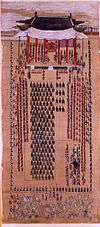
낙남헌방방

봉수당진찬
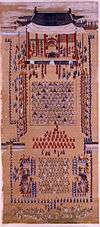
낙남헌양로연
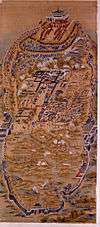
서장대야조
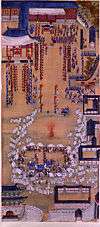
득중정어사
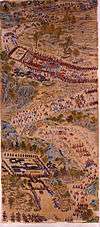
환어행렬
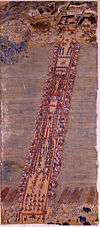
한강주교환어
Map of the Hwaseong Fortress in the 1800 Uigwe.

Artistic license
- The Memoirs of Lady Hyegyeong are in fact a collection of four different documents, written at different times, for different audiences. The description of the controversial behavior of Crown Prince Sado occurs in the 1805 Memoir,[10] ten years after the procession, and not in the 1795 Memoir.[11]
- In the real Court, the red robe was for the highest ranks, the blue for the intermediate ranks, and green for the lowest ranks. In the series, the blue dress is the uniform of the villains, while the red dress is the uniform of the "good ones". This helps the viewer to identify who's who, but this can also be a POV-시파 joke from the screenwriter.[12]
References
- "Performance Information". Suwon-City: Travel & Tourism. Archived from the original on 2010-05-29. Retrieved 2013-05-08.
- Oh Seyeong 2006.
- Haboush 1996.
- Chevalier, 1800 & p. 384-396.
- Doo Won Choo, 2010 & I, p. 82-213.
- Chung, Ah-young (9 February 2009). "Reformative King Jeongjo Was Not Fatally Poisoned". The Korea Times. Archived from the original on 2016-01-06. Retrieved 2013-05-30.
- KCC (2013). "Hwaseong Haenghaeng" (in Korean). Korean Copyright Commission. Archived from the original on 2013-07-03.
- KCC (2013). "Kim Deuksin Hwaseongneunghaengdo" (in Korean). Korean Copyright Commission. Archived from the original on 2016-04-10. Retrieved 2019-08-04.
- "Royal Parade to Hwaseong Fortress". Cultural Heritage Administration. 2013. Retrieved 2013-05-08.
- Haboush, 1996 & p.241-336
- Haboush, 1996 & p.49-137
- Chung, Ah-young (13 November 2007). "Renaissance of Joseon King Jeongjo". The Korea Times. Retrieved 2013-04-02.
Bibliography
- Oh, Seyeong (2006). Journey. 제목:원행; 저자:오세영; 출판사:예담. Yedam (Wisdom House). p. 315. ISBN 9788-9591-3167-9. (in Korean)
- Chevalier, Henri (1898). Cérémonial de l'achèvement des travaux de Hoa Syeng (Corée) 1800. Toung Pao (in French). 9. E. J. Brill. pp. 384–396.CS1 maint: ref=harv (link)
- Doo Won Cho (2010). The Korean fortress City Suwon: History; Conservation Heritage; Documentation "Hwaseong Seongyeok Uigwe"; National and International Relations (in German). University of Bamberg, Inaugural Dissertation. p. 727.CS1 maint: ref=harv (link)
- Haboush, JaHyun Kim (1996). The Memoirs of Lady Hyegyong: The Autobiographical Writings of a Crown Princess of Eighteenth-Century Korea. University of California Press. p. 329. ISBN 978-0520200555.CS1 maint: ref=harv (link)
- Official Web Site of the Hwaseong Fortress
- UNESCO Hwaseong Fortress Site
External links
- Eight Days, Assassination Attempts against King Jeongjo at Daum (in Korean)